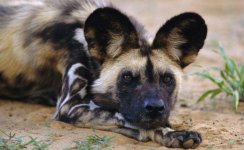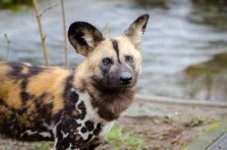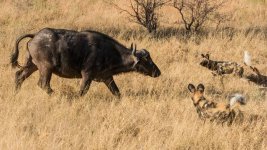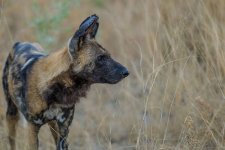Jmrie_
in memoriam 1995-2021
- Joined
- Aug 21, 2017
- Posts
- 104,956
- Solutions
- 1
- Reaction
- 53,216
- Points
- 27,061
- Age
- 28
The African wild dog, also known as African hunting dog, African painted dog, painted hunting dog, or painted wolf, is a canid native to Sub-Saharan Africa. You do not have permission to view the full content of this post.
Log in or register now.
Scientific name: Lycaon pictus
Conservation status: Endangered (Population decreasing) You do not have permission to view the full content of this post. Log in or register now.
Habitat: You do not have permission to view the full content of this post. Log in or register now.
Did you know: The African wild dog is also known as the African hunting dog, Cape hunting dog, spotted dog, painted dog, painted wolf, painted hunting dog, or ornate wolf. You do not have permission to view the full content of this post. Log in or register now.


Ang cute nila pero pwede ka nila kainin kaya ingat
How fast can the African wild dog run when hunting?
African wild dogs hunt co-operatively, usually early in the morning and late in the night. They hunt antelopes, warthogs, wildebeest, rats and birds. African wild dogs are among the most successful hunters in Africa. African wild dog can run 35 miles per hour and travel great distances during the day.
Dagdag kaalaman
. A fascinating physique
Their scientific name, Lycaon pictus, literally means painted wolf, referencing their mottled fur with black, brown, yellow and white colourings. Every dog’s coat has a unique pattern making individuals easy to spot. They have an extremely powerful bite with specialised molars for shearing meat and breaking bone and have exceptionally keen senses of sight, smell and particularly hearing, . Large rounded ears lined with numerous muscles allow the dogs to swivel them like two radar dishes, picking up the minutest of sounds. Long legs, a lean build and rapid muscle recovery all assist in making this animal a formidable endurance hunter.
2. They have a unique social hierarchy
The social structure of a wild dog pack is a fascinating, almost altruistic system. Like other pack animals there is a strict hierarchy, with an alpha breeding pair in charge of the group and the rest of the pack members are all subordinates. When a litter of pups is born, they take priority over even the alphas. At first pups are fed by the dogs regurgitating fresh meat after returning from a hunt, but once old enough, they are taken to the kill and given first choice over the spoils. The other dogs patiently wait on the side lines, standing guard until their turn to feed. They almost never fight amongst themselves over food due to this ranking system. When a dog becomes ill, injured or elderly restricting or even incapacitating their effectiveness as a hunter, the rest of the pack cares for and feeds them. Recently the alpha female of a pack in Botswana lost one of her forelegs during a hunt. For any other predator, this would be a death sentence. However, she remained the alpha female for a few years afterwards continuing to breed and raise pups while being looked after by the pack.
Watch this incredible video of Botswana’s wildlife here by You do not have permission to view the full content of this post. Log in or register now.. Natural World Safaris organises tailor-made safaris to a number of African destinations including to private concessions in You do not have permission to view the full content of this post. Log in or register now. known for their populations of wild dog:
3. They are nomads
Wild dogs are nomadic animals and can traverse 50km in a single day. As a result, their territories can range between 400 and 1500 square kilometres. They only remain in one area when denning.
4. Wild dogs are well coordinated
The 80% success rate in wild dog hunts can be attributed mainly to the coordinated nature of the pack. Communication is key and the dogs constantly let one another know both their location and that of the prey. Their high intelligence and teamwork allows them to adapt to changing scenarios during a hunt.

© Richard Denyer
5. They are agile hunters
Most predators rely on s†éálth to hunt their prey, but wild dogs rarely require such tactics. The dogs are built for high stamina chases. A typical hunt will involve the pack spreading out in a line to cover more ground and give each member space to manoeuvre. Upon finding prey the dogs will immediately approach and test the animals’ defences, probing a herd for any weak members. Once a target is selected, the pack attempts to panic and separate the herd. The pack then gives chase to the selected individual, with some dogs performing flanking movements to cut off any avenues of escape. Like an Olympic cycling team, the dog at the head of the chase will pull back as they tire and another one will take their place. Eventually, after a few kilometres, the prey begins to become exhausted. At this point the pack, with their high endurance and teamwork, easily take the animal down.
Another favourite tactic of the wild dogs is to herd their prey towards rivers, lakes and other bodies of water. Most wildlife in Africa is afraid of deep water due to the risk of crocodiles. So when an animal is chased towards water it will either be brave enough to dive in, or, the more likely outcome is that they will panic, turn back into their pursuers and be quickly dispatched. Sometimes the dogs use tactics similar to the lions, where one pack member flushes out and drives prey into the others waiting in ambush.
6. They have few natural enemies
Humans are easily the largest threat to the wild dogs’ survival. For a very long time they were considered pests though there was little to no evidence suggesting so. They would only go after livestock if desperate, and to this day there are no recorded incidents in Africa of wild dogs attacking humans. In the wild, lions are the dogs’ main threat. When an area has a high population density of lions, it directly correlates to a low population of wild dogs. Other predators, while still a threat, generally don’t cause the dogs any problems. Hyenas will attempt to s†éál kills from them but wouldn’t hunt ãdül† members of the pack.
7. We are the reason they are endangered
The reason why there are only about 5,000 African wild dogs left is mainly down to people. Farmers, believing them to be vermin, would shoot any dogs they saw, sometimes even tracking down dens and poisoning the inhabitants inside. Poachers’ snares meant for other game and human civilisation encroaching on their habitats also contribute. The main causes of their population decline though are diseases such as rabies, contracted usually from domestic animals. Because of their highly social nature one rabid wild dog would quickly infect the rest of the pack, wiping them out entirely.
8. Wild dogs have great relationship values
The dominant pair is monogamous and would usually be the only ones to breed in a pack, though a beta pair does sometimes produce pups as well, which are then either killed or adopted by the alpha pair. Each litter can have between four and 12 pups. Unlike most other pack animals, male wild dogs tend to stay within their pack’s territory once reaching sexual maturity, whereas the females will travel long distances to find a mate. This behaviour is a good countermeasure against inbreeding.

© Richard Denyer
9. An interesting set of genetics
African wild dogs used to be found across the whole continent but are now limited to countries in the south and east of Africa, the main strongholds being in the Okavango Delta and the Selous Game Reserve. East African wild dogs are slightly smaller than their counterparts in the south. There are five subspecies of wild dog in Africa; the Cape wild dog, the East African wild dog, the West African wild dog, the Chadian wild dog and the Somali wild dog, though the genetic diversity of these subdivisions is under debate. Although wild dogs do share a common ancestor with wolves from a few million years ago, they are not genetically compatible, so interbreeding with any other canid isn’t possible. The selective breeding applied to domesticated dogs which formed the different breeds could never work with African wild dogs.
10. They cannot be domesticated
People have attempted to tame wild dogs but never successfully. They are naturally distrusting of humans or indeed any animal outside of their own pack. When humans have domesticated dogs in the past, it was due to certain character traits prevalent in canines that could be amplified through breeding. One of these traits was a willingness to be touched by humans. This combined with traits of curiosity and opportunism paved the way for humanity’s greatest symbiotic relationship with an animal affectionately named “man’s best friend.” Wild dogs have never displayed these traits and it is unlikely they ever will.
Source
You do not have permission to view the full content of this post. Log in or register now.
Wikipedia
Google
Scientific name: Lycaon pictus
Conservation status: Endangered (Population decreasing) You do not have permission to view the full content of this post. Log in or register now.
Habitat: You do not have permission to view the full content of this post. Log in or register now.
Did you know: The African wild dog is also known as the African hunting dog, Cape hunting dog, spotted dog, painted dog, painted wolf, painted hunting dog, or ornate wolf. You do not have permission to view the full content of this post. Log in or register now.


Ang cute nila pero pwede ka nila kainin kaya ingat
How fast can the African wild dog run when hunting?
African wild dogs hunt co-operatively, usually early in the morning and late in the night. They hunt antelopes, warthogs, wildebeest, rats and birds. African wild dogs are among the most successful hunters in Africa. African wild dog can run 35 miles per hour and travel great distances during the day.
Dagdag kaalaman
. A fascinating physique
Their scientific name, Lycaon pictus, literally means painted wolf, referencing their mottled fur with black, brown, yellow and white colourings. Every dog’s coat has a unique pattern making individuals easy to spot. They have an extremely powerful bite with specialised molars for shearing meat and breaking bone and have exceptionally keen senses of sight, smell and particularly hearing, . Large rounded ears lined with numerous muscles allow the dogs to swivel them like two radar dishes, picking up the minutest of sounds. Long legs, a lean build and rapid muscle recovery all assist in making this animal a formidable endurance hunter.
2. They have a unique social hierarchy
The social structure of a wild dog pack is a fascinating, almost altruistic system. Like other pack animals there is a strict hierarchy, with an alpha breeding pair in charge of the group and the rest of the pack members are all subordinates. When a litter of pups is born, they take priority over even the alphas. At first pups are fed by the dogs regurgitating fresh meat after returning from a hunt, but once old enough, they are taken to the kill and given first choice over the spoils. The other dogs patiently wait on the side lines, standing guard until their turn to feed. They almost never fight amongst themselves over food due to this ranking system. When a dog becomes ill, injured or elderly restricting or even incapacitating their effectiveness as a hunter, the rest of the pack cares for and feeds them. Recently the alpha female of a pack in Botswana lost one of her forelegs during a hunt. For any other predator, this would be a death sentence. However, she remained the alpha female for a few years afterwards continuing to breed and raise pups while being looked after by the pack.
Watch this incredible video of Botswana’s wildlife here by You do not have permission to view the full content of this post. Log in or register now.. Natural World Safaris organises tailor-made safaris to a number of African destinations including to private concessions in You do not have permission to view the full content of this post. Log in or register now. known for their populations of wild dog:
3. They are nomads
Wild dogs are nomadic animals and can traverse 50km in a single day. As a result, their territories can range between 400 and 1500 square kilometres. They only remain in one area when denning.
4. Wild dogs are well coordinated
The 80% success rate in wild dog hunts can be attributed mainly to the coordinated nature of the pack. Communication is key and the dogs constantly let one another know both their location and that of the prey. Their high intelligence and teamwork allows them to adapt to changing scenarios during a hunt.

© Richard Denyer
5. They are agile hunters
Most predators rely on s†éálth to hunt their prey, but wild dogs rarely require such tactics. The dogs are built for high stamina chases. A typical hunt will involve the pack spreading out in a line to cover more ground and give each member space to manoeuvre. Upon finding prey the dogs will immediately approach and test the animals’ defences, probing a herd for any weak members. Once a target is selected, the pack attempts to panic and separate the herd. The pack then gives chase to the selected individual, with some dogs performing flanking movements to cut off any avenues of escape. Like an Olympic cycling team, the dog at the head of the chase will pull back as they tire and another one will take their place. Eventually, after a few kilometres, the prey begins to become exhausted. At this point the pack, with their high endurance and teamwork, easily take the animal down.
Another favourite tactic of the wild dogs is to herd their prey towards rivers, lakes and other bodies of water. Most wildlife in Africa is afraid of deep water due to the risk of crocodiles. So when an animal is chased towards water it will either be brave enough to dive in, or, the more likely outcome is that they will panic, turn back into their pursuers and be quickly dispatched. Sometimes the dogs use tactics similar to the lions, where one pack member flushes out and drives prey into the others waiting in ambush.
6. They have few natural enemies
Humans are easily the largest threat to the wild dogs’ survival. For a very long time they were considered pests though there was little to no evidence suggesting so. They would only go after livestock if desperate, and to this day there are no recorded incidents in Africa of wild dogs attacking humans. In the wild, lions are the dogs’ main threat. When an area has a high population density of lions, it directly correlates to a low population of wild dogs. Other predators, while still a threat, generally don’t cause the dogs any problems. Hyenas will attempt to s†éál kills from them but wouldn’t hunt ãdül† members of the pack.
7. We are the reason they are endangered
The reason why there are only about 5,000 African wild dogs left is mainly down to people. Farmers, believing them to be vermin, would shoot any dogs they saw, sometimes even tracking down dens and poisoning the inhabitants inside. Poachers’ snares meant for other game and human civilisation encroaching on their habitats also contribute. The main causes of their population decline though are diseases such as rabies, contracted usually from domestic animals. Because of their highly social nature one rabid wild dog would quickly infect the rest of the pack, wiping them out entirely.
8. Wild dogs have great relationship values
The dominant pair is monogamous and would usually be the only ones to breed in a pack, though a beta pair does sometimes produce pups as well, which are then either killed or adopted by the alpha pair. Each litter can have between four and 12 pups. Unlike most other pack animals, male wild dogs tend to stay within their pack’s territory once reaching sexual maturity, whereas the females will travel long distances to find a mate. This behaviour is a good countermeasure against inbreeding.

© Richard Denyer
9. An interesting set of genetics
African wild dogs used to be found across the whole continent but are now limited to countries in the south and east of Africa, the main strongholds being in the Okavango Delta and the Selous Game Reserve. East African wild dogs are slightly smaller than their counterparts in the south. There are five subspecies of wild dog in Africa; the Cape wild dog, the East African wild dog, the West African wild dog, the Chadian wild dog and the Somali wild dog, though the genetic diversity of these subdivisions is under debate. Although wild dogs do share a common ancestor with wolves from a few million years ago, they are not genetically compatible, so interbreeding with any other canid isn’t possible. The selective breeding applied to domesticated dogs which formed the different breeds could never work with African wild dogs.
10. They cannot be domesticated
People have attempted to tame wild dogs but never successfully. They are naturally distrusting of humans or indeed any animal outside of their own pack. When humans have domesticated dogs in the past, it was due to certain character traits prevalent in canines that could be amplified through breeding. One of these traits was a willingness to be touched by humans. This combined with traits of curiosity and opportunism paved the way for humanity’s greatest symbiotic relationship with an animal affectionately named “man’s best friend.” Wild dogs have never displayed these traits and it is unlikely they ever will.
Source
You do not have permission to view the full content of this post. Log in or register now.
Wikipedia
Attachments
-
You do not have permission to view the full content of this post. Log in or register now.